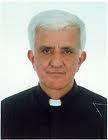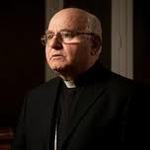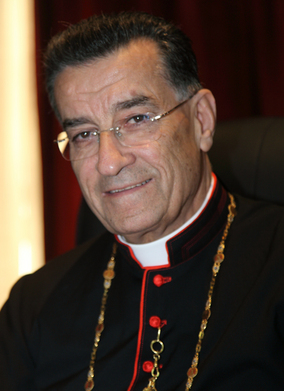Archbishops Youssef Anis Abi-Aad, 72, and Jean-Clément Jeanbart, 69, have taken refuge in other places since their residences were ransacked in the past few days. Clashes between Assad’s forces and other groups are to blame. It is said that “unidentified groups, who want to foster a sectarian war and involve the Syrian people in a sectarian strife.” Not a much more is known at this point.
Tag: Maronite
Melkite and Maronite Churches begin Lent today
 The Byzantine Catholic Church, along with the Maronite
The Byzantine Catholic Church, along with the Maronite
Church, begin the Lenten observance. The Byzantines call today Clean Monday,
the first day of the Great Fast. Maronites call today “Ash Monday.” The
Byzantine Orthodox Church will open their Lent on Monday, February 27.
the Byzantines the traditional liturgical practice is to celebrate Great
Compline, which will include the singing of a portion of the Great Canon of
Saint Andrew of Crete. Find a Melkite parish near you to celebrate
Compline tonight.
Continue reading Melkite and Maronite Churches begin Lent today
Maronite Bishop admonishes Obama for rebuff of Patriarch Béshara Raï
Patriarch
Béshara Raï, 71, is making a pastoral visit to the Maronite Catholic
communities in both US eparchies from 4 to 23 October 2011. His Beatitude will visit Eparchy of Our Lady of Lebanon and the Eparchy of St Maron of Brooklyn.
President Barack Obama has roundly refused to meet the Patriarch. Bishop Gregory openly makes the case that it is a mistake of the current administration to ignore His Beatitude’s visit to the USA.
Béshara Raï, was elected on March 15, 2011 as the 77th Patriarch of the Maronite Church.
Bishop Gregory’s letter:
September 30, 2011
Dear Mr. President:
I am terribly
disappointed with the rebuff of Patriarch Bechara Peter Rai who is the Catholic
leader of the Maronites worldwide and one of the most respected Christian
leaders in Lebanon and the Middle East . The motto of his coat of arms
reflects his personality and is call for “communion and love.” He has been
trying to achieve what no other Middle Eastern political or a religious leader
has been able to do: meet others with respect and love, not take sides,
and build bridges to a future that will hopefully lead to peace and happiness
for all people in the Middle East.
Muslim and Christian groups have all found
in him a real father, a Patriarch. Because he has spoken out expressing
his concern for the future of Christians in the Middle East , he has been
rebuffed by you and your Administration. It is pure hypocrisy for the
leader of the free world to refuse to meet with Patriarch Rai especially since
the Prime Minister of Israel can come and completely disregard essential parts
of a peace plan and still be given a warm welcome, and the King of Saudi
Arabia, where Christians have no freedom whatsoever, can be received with highest
honors. Mr. President, you are ignoring the plight of Christians in the Middle
East!
Patriarch Rai’s warning about the future of Christians in Syria is not
taboo. Christians are in a state of peril in the same way that Christians of
Iraq were a few years ago when two thirds of them migrated out of the country
and are still not protected to this day. To say the Patriarch supports
dictators and sides with terrorists is pure nonsense. With his own unique
charisma, Patriarch Rai has reached out to all Lebanese with whom he has to
live side-by-side. It is a beautiful outreach, one that is uniquely his,
without having to be beholden to anyone. He speaks with love and tempers
the divisive, hateful talk of many. He gives hope
A new day is dawning in the
Middle East. The Arab Spring is happening with little vision for the
summer that will ensue. Mr. President, you do not have to agree on
everything with Patriarch Rai, but there is no need to avoid or rebuff
him. By doing so, you are showing your disrespect for him and for all
Christians of the Middle East.
Bishop of the Eparchy of
Saint Maron of Brooklyn
Patriarch Béshara Raï begins new ministry as the Maronite head and father working on unity
The video of Patriarch Béchara Peter Raï’s enthronement Liturgy on March 25, 2011.
Béshara Raï elected new Maronite Patriarch
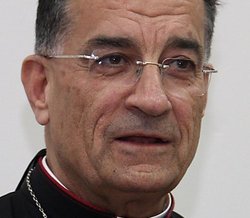 Only 20 years junior to the out-going patriarch, His Beatitude Nasrallah Peter Sfeir, the Maronite bishops elected today Bishop Béshara Raï, 71, as the new patriarch. He’s 77th patriarch of the Maronites; Raï takes up the See of St Peter (Peter’s first diocese before moving to Rome), adopting the name Peter. He will be known as “His Beatitude, Patriarch Béshara Peter Raï.“
Only 20 years junior to the out-going patriarch, His Beatitude Nasrallah Peter Sfeir, the Maronite bishops elected today Bishop Béshara Raï, 71, as the new patriarch. He’s 77th patriarch of the Maronites; Raï takes up the See of St Peter (Peter’s first diocese before moving to Rome), adopting the name Peter. He will be known as “His Beatitude, Patriarch Béshara Peter Raï.“
Patriarch Nasrallah Peter Sfeir, retires as Maronite leader
 Today, Pope Benedict XVI accepted the petition of His Beatitude, Patriarch Nasrallah Peter Sfeir, cardinal, to retire from his pastoral leadership as the Father of Maronite Church.
Today, Pope Benedict XVI accepted the petition of His Beatitude, Patriarch Nasrallah Peter Sfeir, cardinal, to retire from his pastoral leadership as the Father of Maronite Church.
Maronites remember founder, Saint Maron
 1600 years is a long time. But the Church never forgets. She especially never forgets a sainted monk who called together others to live the Gospel and to pray. Maronite Church who traces her foundation to a monk is remembering his good work and his death of so long ago. Several celebrations around the US mark the anniversary.
1600 years is a long time. But the Church never forgets. She especially never forgets a sainted monk who called together others to live the Gospel and to pray. Maronite Church who traces her foundation to a monk is remembering his good work and his death of so long ago. Several celebrations around the US mark the anniversary.
Saint Maron
Our Church was not built after a name of a See or Apostle, but rather took its identity from the radiance of a man and a monastery: the Maronite Church, a Church of asceticism and adoration attached from the beginning to a solitary man, not a man of rank or a Church leader.The faith lived out by the hermit Maron became the inner strength of a people’s history. As for the successive migrations from Syria (in the 5-10th centuries), the Maronites gave them one meaning, that is, giving up land, wealth and comfort in Syria moving toward a poor land where anxiety and austerity prevail, so they could preserve their faith and remain attached to their freedom … This event is not a simple historical fact among others … it is the very beginning of a new history, the history of the Maronites.
Lord, Jesus, You called Your chosen one, Saint Maron, to the monastic life, perfected him in divine virtues, and guided him along the difficult road to the heavenly kingdom.
The Maronites: The Origins of an Antiochene Church
From the Website
Abbot Paul Naaman, a Maronite scholar and former Superior General of the Order of Lebanese Maronite Monks, wisely places the study of the origins of the Maronite Church squarely in the midst of the history of the Church. His book, The Maronites: The Origins of an Antiochene Church, published during the sixteenth centenary of Maron’s death, offers plausible insights into her formation and early development, grounding the Maronite Church in her Catholic, Antiochian, Syriac, and monastic roots.
Maronite Patriarch said ready to resign
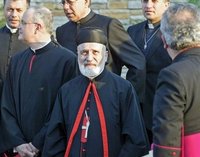 Patriarch Nasrallah Peter Sfeir, 90, the 76th head of the Maronite Church is said to have submitted a resignation a few months ago to His Holiness, Pope Benedict XVI. The Daily Star has stated this move of Sfeir’s, but the paper has several facts wrong, so the reliability of specifics is questionable.
Patriarch Nasrallah Peter Sfeir, 90, the 76th head of the Maronite Church is said to have submitted a resignation a few months ago to His Holiness, Pope Benedict XVI. The Daily Star has stated this move of Sfeir’s, but the paper has several facts wrong, so the reliability of specifics is questionable.
